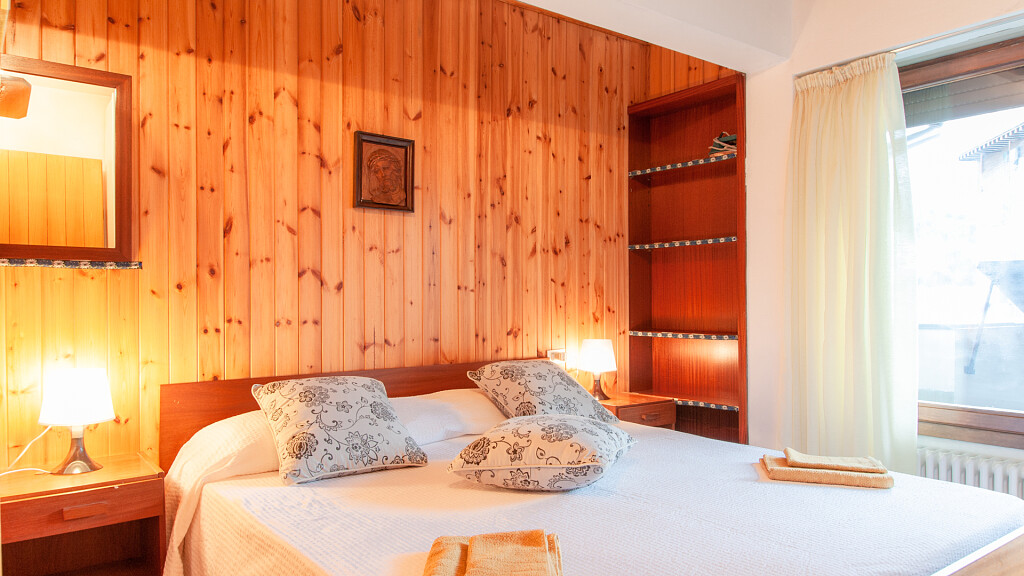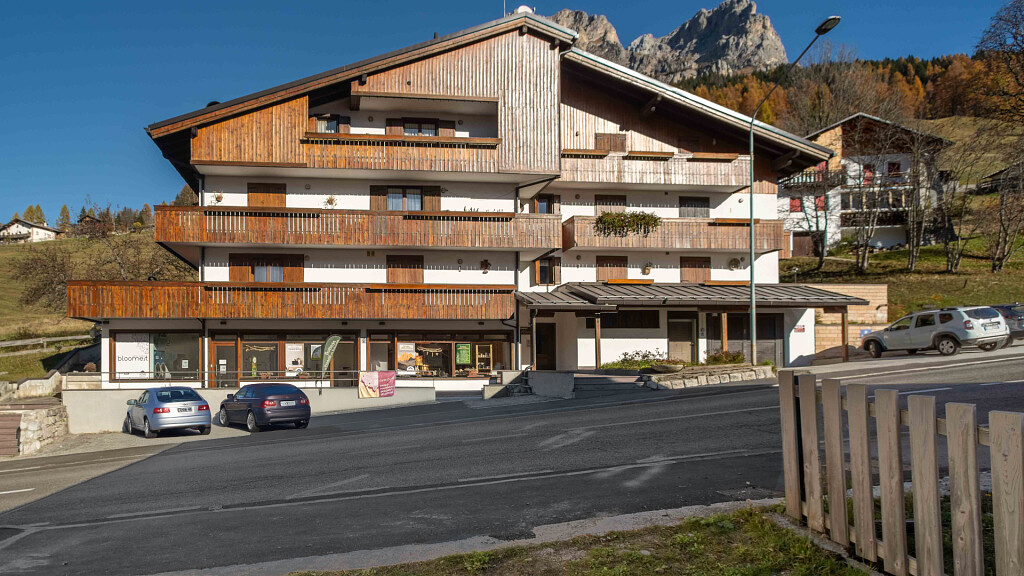Among the most beautiful Dolomite valleys we find the Biois valley (Val del Biois in Italian). A valley, in the province of Belluno (Veneto region), surrounded by some of the most breathtaking mountains of the Dolomites: the Marmolada, the Civetta, the Cime d’Auta and the Focobon and Mulaz Group which who are part of the Pale di San Martino northern crown.
The Biois valley covers about 20km from Passo San Pellegrino to Cencenighe Agordino. Its name comes from the torrent that flows along the whole valley: the Biois torrent.
This valley is a typical tourist destination for nature lovers and it’is also a real open-air museum: walking along the streets of the villages you come across paintings and sacred frescoes that adorn the houses. These works were made between the middle of 1600 and the middle of 1800, which identify the Biois valley as "the Valley with the Saints at the windows".
The main centre of the Biois valley is Falcade, a winter tourist destination for families and a strategic starting point for many summer activities.
So, what can you do and see in Falcade and the Biois valley?
1) Skiing in the Biois valley
For winter sports lovers the Biois valley offers several options.
The San Pellegrino Ski Area, easily reachable from Falcade by cable car in Molino, give access to 60 km of ski slopes of different length and difficulty, a snow park for snowboarders and school camps for children.
Nordic skiing lovers have two alternatives: the "Pietro Scola Centre” in Falcade offers 10 km of slopes both in the woods and in the Piana di Falcade in a sunny and very panoramic area, and the "Franco Manfroi Centre” in Canale d'Agordo with a more technical route of 7 km through woods and frozen waterfalls.
In the Biois valley there are also trails for alpine skiing and snow shoes.
2) The characteristic "Tabià"
Walking through the streets of the Biois valley it is impossible not to notice the old wooden barns typical of the Dolomites. In the villages of Falcade, Canale d'Agordo and Vallada Agordina you can admire over 300 Tabià.
The Tabià were used in the past as barns and warehouse, with the classic stone base welcomed the stable in which the animals provided for the families. This is why the Tabià are often located adjacent to the houses.
A little curiosity: on the main wooden beam of the roof is engraved the date of construction and subsequent restorations.
3) The Valfredda valley
Walking through the streets of the Biois valley it is impossible not to notice the old wooden barns typical of the Dolomites. In the villages of Falcade, Canale d'Agordo and Vallada Agordina you can admire over 300 Tabià.
The Tabià were used in the past as barns and warehouse, with the classic stone base welcomed the stable in which the animals provided for the families. This is why the Tabià are often located adjacent to the houses.
A little curiosity: on the main wooden beam of the roof is engraved the date of construction and subsequent restorations.
4) The “Piana of Falcade”
Visiting the Biois valley you must stop in the wonderful Piana of Falcade: a large grassy area in the center of Falcade, ideal place for families in the summer season and sport center in the winter months.
The Piana has a play area for children, a barbecue area and an alpine lake in the center. It’s a strategic position to create unforgettable memories surrounded by a beautiful landscape of the Dolomites.
The Piana of Falcade is a famous place for important events such as "Se Desmonteghea", the festival of traditional farming in the Biois valley that occurs every year on the last weekend of September. A folkloric event with a highly anticipated historical and cultural value, which attracts many visitors every year.
5) Church of San Simon in Vallada Agordina and Church of Jore
On the slopes of Mount Celentone, in Vallada Agordina, there is the church of San Simon: a small church in Alpine Gothic style with a high cultural value, declared a national monument in 1877.
The church, surrounded by spruce and larch woods, is the oldest place of worship in the Biois valley. Inside you can admire the Paris Bordon’s frescoes of 1500.
Starting from the panoramic village of Sappade near Falcade, the small Church of Jore can be reached with a simple walk through the woods.
Every year in May citizens come together to celebrate a mass and party outside the church.
6) Canale d'Agordo: the birthplace of Pope John Paul I
Canale d'Agordo, once called Forno di Canale, is a characteristic village of the Biois valley, famous for being the birthplace of Pope John Paul I.
From the main square is accessible the museum dedicated to the pontiff -MUSAL: Albino Luciani museum-, while in the village you can visit the birth house of Pope John Paul I.
Canale d'Agordo is famous for being the town where the first Cooperative Dairy of Italy was founded in 1872. The idea was from the Archpriest Don Antonio Della Lucia who, to put a stop to the numerous emigrations of that time, devised a system of collective processing of milk whose proceeds could be invested for the community.
In Canale d'Agordo was also born one of the first breweries of Italy in 1847.
The most important event of the carnival in Biois valley is the famous Zinghenesta of Canale d'Agordo. Every year, on the Sunday before Shrove Tuesday, many visitors follow the procession that starts from Falcade and ends in Canale d'Agordo, at the "Casa delle Regole", to welcome the new Zinghenesta: the most beautiful girl in the country and the main carnival mask.
The festival continues with a dancing procession through the streets of Canale. In order of parade, after the main character, we find: “Matèl”, the character who announces the beauty, accompanied by his own “Lachè”, the “Paiàzo” (the clown), numerous wooden masks: "beautiful masks" with elegant clothes and "ugly masks" scary masks called “Puster”. Finally, the parade closes with the “Sasìgn” (the killers), “el Caoròn Spion” (the spying goat) and the “Gendarmi” (the police). A real Dolomite carnival rich in traditions, suitable for families and children.
7) Waterfalls in the Biois valley
For nature lovers in the Biois valley there is picturesque waterfalls reachable with simple walks for families.
The Cascata delle Barezze is located in a small canyon formed by the Gavon stream in the panoramic hamlet of Sappade (Falcade). Starting from the little village you can enjoy a magnificent view of the Civetta and, with a short walk through the woods, you reach the bridge over the waterfall. From here you can descend to admire the waterfall up close.
Another unmissable destination is in the Garés valley in Canale d'Agordo: the majestic Garés waterfalls. Formed by the Liera torrent, whose waters flow from the Orrido delle Comelle and flow along the whole valley until they also flow into the Biois torrent, the waterfalls are easily accessible and are a popular destination for adults and children.
Starting from Capanna Cima Comelle a simple path among curious intertwined roots and wooden stairs, you find first the Lower Waterfall and, not far away, the High Waterfall. The power of the water breaking on the rock will surely leave you breathless.
8) The Cavalera walk
From the Piana of Falcade starts a quiet path along the Biois stream that leads to Canale d'Agordo: the Cavalera walk, an ancient communication route between the two villages. The route can also be extended to Cencenighe Agordino.
On the anniversary of the thirty years since the election of Albino Luciani as Pope, in 2008 the Via Crucis Papa Luciani was inaugurated along the Cavalera. The work, composed of 15 bronze tiles mounted on white dolomite boulders, was created by the artist Franco Murer from Falcade.
The Cavalera is suitable for strollers, mountain bikes and e-bikes.
9) Dolomites in miniature
At the confluence of the Biois valley with the Val Cordevole valley you can find, above the village of Cencenighe Agordino, San Tomaso Agordino: a typical summer village.
Starting from the hamlet of Celat, begins one of the most evocative paths of the Biois valley: the Dolomites in miniature. Along the path immersed in the woods, for about 5 km, you can see numerous rock sculptures faithful miniature reproductions of the most famous Dolomite peaks such as Civetta, Pelmo, Tre Cime di Lavaredo, Torri del Vajolet, Antelao and many others.
Every year internationally renowned artists come in San Tomaso Agordino to sculpt on blocks of Serla dolomite, real works of art that portray some of the most iconic peaks of the Dolomites.
The path of the Dolomites in miniature reaches the Forcella San Tomaso where there is one of the most romantic sculptures: “el Cor”, a rock shape of heart that you can see in the San Lucano valley in Taibon Agordino.
10) Bike paths in the Biois valley
For mountain biking and e-bike lovers the Biois valley offers many excursions, surrounded by woods or along panoramic trails.
In addition to the already mentioned Cavalera that connects Falcade to Canale d'Agordo through a simple path along the Biois stream, the path that leads to the Church of Jore from the village of Sappade, and the beautiful Garés valley, in Falcade and surroundings there are many other routes to go by mountain bike.
The Giro delle Coste is a simple panoramic route that from the hamlet of Somor (Falcade) reaches the hamlet of Tabiadon di Canes. The trail is accessible on foot or by mountain bike. Along the route you can’t miss the imposing Focobon Group and the Civetta mountain.
For adrenaline lovers the San Pellegrino Ski Area in the summer months offers numerous mountain bike trails and downhill trails. The San Pellegrino Bike Trail gives the opportunity to test paths of different difficulty and length, between wooden parabolics and breathtaking views.


























